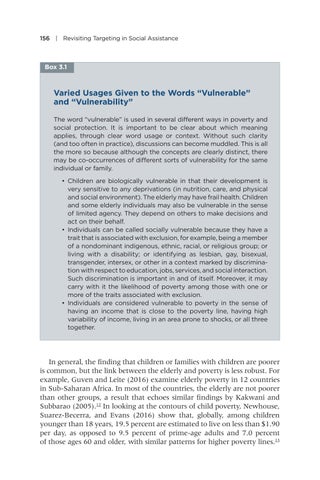156 | Revisiting Targeting in Social Assistance
Box 3.1
Varied Usages Given to the Words “Vulnerable” and “Vulnerability” The word “vulnerable” is used in several different ways in poverty and social protection. It is important to be clear about which meaning applies, through clear word usage or context. Without such clarity (and too often in practice), discussions can become muddled. This is all the more so because although the concepts are clearly distinct, there may be co-occurrences of different sorts of vulnerability for the same individual or family. • Children are biologically vulnerable in that their development is very sensitive to any deprivations (in nutrition, care, and physical and social environment). The elderly may have frail health. Children and some elderly individuals may also be vulnerable in the sense of limited agency. They depend on others to make decisions and act on their behalf. • Individuals can be called socially vulnerable because they have a trait that is associated with exclusion, for example, being a member of a nondominant indigenous, ethnic, racial, or religious group; or living with a disability; or identifying as lesbian, gay, bisexual, transgender, intersex, or other in a context marked by discrimination with respect to education, jobs, services, and social interaction. Such discrimination is important in and of itself. Moreover, it may carry with it the likelihood of poverty among those with one or more of the traits associated with exclusion. • Individuals are considered vulnerable to poverty in the sense of having an income that is close to the poverty line, having high variability of income, living in an area prone to shocks, or all three together.
In general, the finding that children or families with children are poorer is common, but the link between the elderly and poverty is less robust. For example, Guven and Leite (2016) examine elderly poverty in 12 countries in Sub-Saharan Africa. In most of the countries, the elderly are not poorer than other groups, a result that echoes similar findings by Kakwani and Subbarao (2005).12 In looking at the contours of child poverty, Newhouse, Suarez-Becerra, and Evans (2016) show that, globally, among children younger than 18 years, 19.5 percent are estimated to live on less than $1.90 per day, as opposed to 9.5 percent of prime-age adults and 7.0 percent of those ages 60 and older, with similar patterns for higher poverty lines.13


